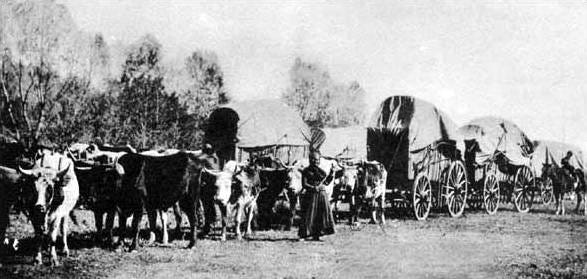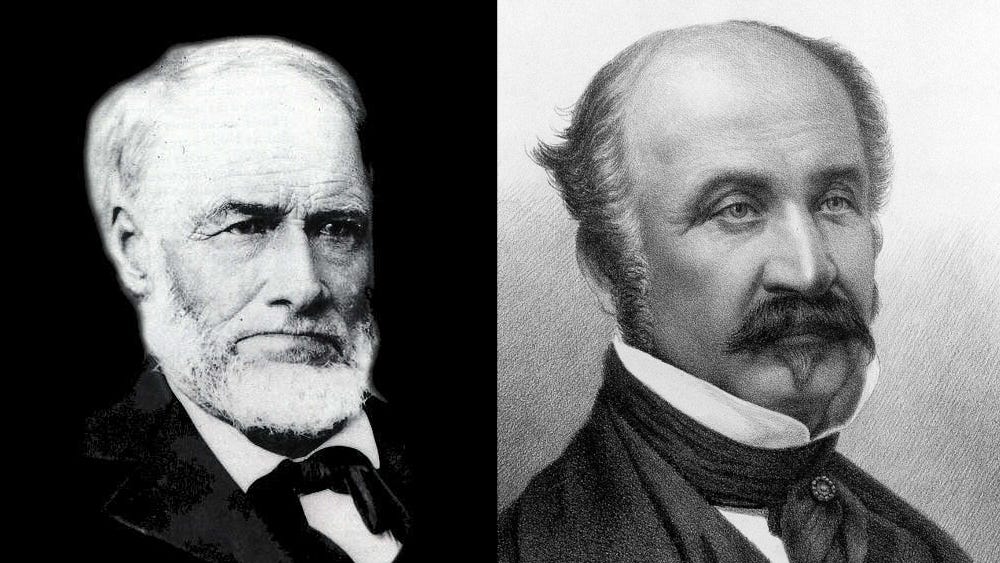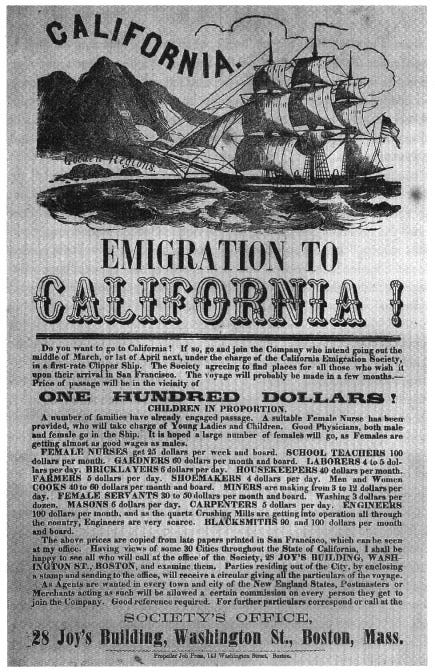Two Fates during the California Gold Rush
The stories of James Marshall and the Murphy Brothers
Meridians is a Newsletter and Podcast featuring real stories from history. Each week, I explore a different topic connected in some way to the previous week’s topic.
Through this format, I hope to make connections through history across cultures and throughout the world.
Two Fates during the California Gold Rush
January 24, 1848, would prove to be a life-changing day for James W. Marshall. He was hired by Johann Sutter to build a sawmill on the American River near Coloma, California. He was examining the waterway below the sawmill and noticed shiny flecks in the water. Curious, he walked in, reached down to the bottom, and pulled out two pieces of shiny rocks. He carefully examined them. One rock was bright and brittle. It turned out to be iron. The other rock was gold and bright, yet malleable. He tried to break the rock, but he just beat it into a different shape.
He gathered more rocks and showed them to another worker. When asked what it was, Marshall said, "Gold, I know it to be nothing else." This discovery was the beginning of the California Gold Rush.
Wagon Trains, Wars, and Gold
James W. Marshall arrived in Oregon in 1844 as part of a wagon train. For a year, he did carpentry in Oregon's Willamette Valley and then wandered south into California. It was there that he first met Johann Sutter. Recognizing Marshall's skills as a craftsman, Sutter hired him to make tools, furniture, spinning wheels, looms; basically anything that can be made and sold from wood.
In 1846, Marshall got involved in the Mexican-American war as it spread to California. The result of the war was that California became independent of Mexico. One way or another, this seemed inevitable.
After a year, he was discharged and returned back to Sutter's employment. Marshall then convinced Sutter that they should build a sawmill on the American River. They both must have thought it would be a more profitable venture to be the wood supplier rather than a craftsman or a shopkeeper.
While they were constructing and setting up this sawmill, Marshall made his famous discovery of gold in the river below the sawmill. This was January of 1848. He took this discovery to Sutter, and they conducted tests to make sure it really was gold. First, they pounded a nugget with an anvil to prove its malleability; then, they boiled the gold flakes in lye soap. After that, they tested the nuggets with nitric acid. Gold doesn't respond to nitric acid, so any reaction from the acid would prove that other metals were mostly present. Nothing happened. It was really gold. After further testing, they believed it to be about 23 karat gold, or 96% pure.
Sutter and Marshall tried to keep the discovery a secret, but by the spring of 1848, the word was getting out. In particular, a merchant in San Francisco by the name of Sam Brannan started waving a bottle filled with glittering gold dust at San Franciscans.
"Gold!" "Gold from the American River!"
He might as well have been shooting off a starter pistol in the rush to find gold. Within days, half of the city of San Francisco had departed to the Coloma area to search for gold. Hysteria might be an applicable word here.
Forging the West
Now let's introduce the Murphy Brothers, John and Daniel. These were two guys whose lives would be forever changed by the discovery of gold in California.
These were bold men, adventurous types. In 1844, they were part of a wagon train that was the first immigrant party to cross the Sierra Nevada into California, back when it was still controlled by Mexico. The famous and tragic Donnor party took the same route, though they took it too late in the year. In fact, Martin Murphy, John and Daniel's Father, was actually part of the party that helped rescue the Donnor party.
In 1846, the Murphys would be involved in the Bear Flag Rebellion. This was a successful independence movement to make California Independent from Mexico. The rebellion took about a month that summer, with some minor scuffles and only a few deaths at most. As a result, California was an independent nation for about 25 days, after which the U.S. Navy arrived and swiftly claimed territory for the United States.
Flash forward to the summer of 1848. The news of the Gold on the American River had reached the Murphy brothers. They, like so many others, pulled up stakes and moved closer to the area where gold was found. They weren't the first to arrive in the area, but they were significant in their presence and seemed to have the capital and ability to set up a serious operation. They’d already had experience mining, though unsuccessfully. Still, they had the advantage of experience on their side, unlike so many amateurs who had no experience with mining at all. They set up a trading post in a spot that would eventually be named after them: "Murphys." From there, they were successful at hiring native Americans to do the mining.
From here, the two brothers would start to make a lot of money from gold mining and their trading post. Either the Murphys were going to make money from Gold, or they were going to make money from selling to gold prospectors at the trading post. Their bets were hedged, and they played their best hand.
Fortune’s Sour
Meanwhile, a ways north in the Coloma area, things aren't going so well on the Sutter property. Since the word got out about the gold, James Marshall and Johann Sutter started having problems keeping any workers at the sawmill. All of the employees quit. They wanted to get rich prospecting and mining gold. After all, it was right there in the river!
After the news had spread to San Francisco and the rest of California, people started flocking to the Coloma area. The fate of Johann Sutter and his fortune was one of terrible timing. Sutter had been given a grant for the land he was occupying in order to build his sawmill business. The problem was that the grant was given to him by the Mexican government in 1841. With the United States taking control of the entire region, the claim Sutter had on the land was evaporating at the worst possible moment. This also meant that James W. Marshall had no claim either, despite having been the one who found all this gold in the first place.
Sutter did have other business ventures besides the sawmill. He had a large agricultural estate known as New Helvetica. Unfortunately, this enterprise would also be a victim of the gold rush. With a literal rush of people descending upon the area, squatters destroyed his crops, killed his livestock, and polluted his rivers. This was the wild west in full bloom.
To make matters worse, the U.S. government finally denied his claim on the land he'd been occupying for his Sawmill. He then tried his own hand at Gold mining. But this venture ends up failing. Sutter ended up selling his assets and moving north to Yuba. For the next 30 years, he petitioned the U.S. government for compensation for the gold discovery. He died of a heart attack in 1880 without a penny of compensation from anyone.
As for James Marshall, his fate wasn't much better. He parted ways with Sutter and left the Coloma area. He bounced around California, trying to find another big gold strike. He eventually settled back in the Coloma area and started a vineyard. This business was profitable for a while, but eventually, he would be driven out of business by competition. Then he tried his hand at gold prospecting and became a partner in a gold mine near Kelsey, California, throwing every bit of money he had trying to strike it rich. The mine failed. He nearly went bankrupt in the effort.
Marshall lived out the rest of his days in Kelsey, earning a meager living. When he died, his body was taken back to Coloma and a bronze statue was set up in commemoration of his gold discovery.
They Came, They Conquered, then got Rich
Unlike Marshall and Sutter, the Murphys got rich. Very rich. They were two of the most successful gold prospectors during the gold rush. Within a year of starting their 1848 mining operation, they had made over $1.5 Million dollars, or roughly $40 million in today's dollars.
The town of Murphys still exists today in the spot where John and Daniel first set up their trading post. While much of the town burned in a fire in 1859, the Murphys Historic Hotel still stands and has had some really distinguished guests, including J.P. Morgan, Mark Twain, and former President Ulysses S. Grant.
Tens of millions of dollars worth of gold was extracted each year for several years during the California Gold Rush. Peaking in 1851 with $81 million dollars worth of gold extracted. While it may have seemed like a bunch of people got rich, the truth was there were so many people who rushed to California that it diluted their chances of great wealth. In fact, in 1848, the daily earnings for individual miners dropped significantly, from about $20 a day in 1848 to less than $8 a day by 1851. It's not a bad wage at all for the time. But, the real winners in the California gold rush were the people selling goods and supplying the miners. While mining gold was a very high-risk, high-reward proposition, the old trusted axiom of supply and demand won out.
The fate of the Murphys vs Marshall and Sutter seems partly one of chance. Maybe the Murphys could have ended up picking a bad spot to mine gold. Maybe Marshall and Sutter both could have picked the perfect mining operations to invest in. But, besides luck, the Murphys seemed to have a better business sense. If their mine had failed, they’d have still made a good living off of their trading post. On the other hand, Sutter and Marshall seemed to constantly miss the mark in their endeavors (or had just given up in Sutter’s case). So, like in all things, chance and action both played a role in the fates of these four men and probably almost anyone involved in the California Gold Rush.
Bonus Material
I found this interesting poster attracting workers to California. I’ve transcribed it below. It really brings to life the sense of adventure that existed at the time.
Transcription:
Do you want to go to California! If so, go and join the Company who intend going out the middle of March or 1st of April next, under the charge of the California Emigration Society, in a first rate Clipper Ship. The Society agreeing to find places for all those who wish it upon their arrival in San Francisco. The voyage will probably be made in a few Months.-
Price of passage will be in the vicinity of
ONE HUNDRED DOLLARS!
CHILDREN IN PROPORTION
A number of families have already engaged passage. A suitable Female Nurse has been provided, who will take charge of Young Ladies and Children. Good Physicians, both male and female go in the Ship. It is hoped a large number of females will go, as Females are getting almost as good wages as males.
FEMALE NURSES get 25 dollars per week and board. SCHOOL TEACHERS 100 dollars per month. GARDENERS 60 dollars per month and board. LABORERS 4 to 5 dollars per day. BRICKLAYERS 6 dollars per day. HOUSEKEEPERS 50 dollars per month. FARMERS 5 dollars per day. SHOEMAKERS 4 dollars per day. Men and Women COOKS 40 to 60 dollars per month and board. MINERS are making from 3 to 12 dollars per day. FEMALE SERVANTS 30 to 50 dollars per month and board. Washing 3 dollars per dozen, MASONS 6 dollars per day. CARPENTERS 5 dollars per day. ENGINEERS 100 dollars per month, and as the quartz Crushing Mills are getting into operation all through the country, Engineers are very scarce. BLACKSMITHS 90 and 100 dollars per month and board.
The above prices are copied from late papers printed in San Francisco, which can be seen at my office. Having views of some 30 Cities throughout the State of California, I shall be happy to see all who will call at the office of the Society, 28 JOY’S BUILDING, WASHINGTON ST. BOSTON, and examine them. Parties residing out of the City, by enclosing a stamp and sending to the office, will receive a circular giving all the particulars of the voyage.
As agents are wanted in every town and city of the New England States, Postmasters or Merchants acting as such will be allowed a certain comission on every person the get to join the Company. Good reference required. For further particulars correspond or call at the
SOCIETY’S OFFICE,
28 Joy’s Building, Washington St. Boston, Mass.
Meridiots: Book 1, Episode 3: A Stunt Double and an Influencer Board the Ship
Meridiots is a serial comic about a group of misfits at sea. They’re going to travel the world and try to understand humanity. Hopefully, with a strong helping of my most idiotic sense of humor, it can resonate with someone!
Book 1 is the introductory book. It’s a learning process for me, so there might be slight changes in design over the next few months.
Hey, you! don’t be a stranger.
“During the gold rush its a good time to be in the pick and shovel business”
-Mark Twain
Recommendations
The Vatican Girl: The Disappearance of Emanuela Orlandi
I’m kind of jaded about crime documentaries. This is somewhat different. It uncovers a side of the Catholic church that you don’t often hear about.
Notes
The thing I really like about history is the sense of adventure that was still alive. Just in the past few hundred years, we’re kind of finding ourselves in a world without frontiers. Outer space and the ocean’s depths seem to be the next frontiers. But unlike so many of the frontiers that came before, their barrier to entry is considerably higher than any previous frontier but several orders of magnitude. Despite the countless hardships our forebearers had to endure, I wonder if they fully realized the gift they were given in having a vast frontier to explore. Considering the obsession people in the 19th century eastern United States had with news of the West, it’s likely they certainly did know the gift they had. It really wasn’t just about gold.
Links
Spotify | Apple | Podcast Addict | Pocket Casts | YouTube












